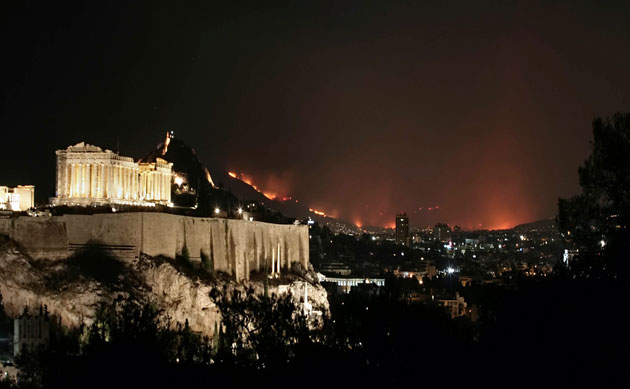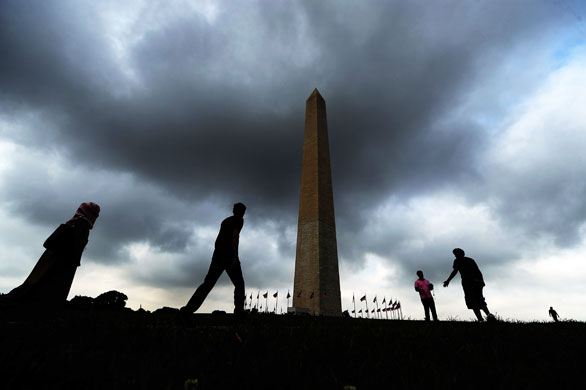When raging wildfires threaten a city, the imagery quickly acquires an allegorical tone. Apocalyptic horizons suggest that much larger catastrophe looms, and civilization itself can seem exposed, unprepared, unprotected. At that moment, the public art of photojournalism becomes capable of both revealing vulnerability and meeting the need for reassurance. Like this:

As fires engulf one side of Athens, Greece, the Parthenon arises above the city in magnificent splendor. Marble bathed in electric light, the monument anchors the image. One could almost image a cosmic battle between firestorm and enlightenment. Culture rises up against Nature, a glorious past against a chaotic future, continuity against conflagration.
In between lies the city. Although hundreds of thousands of people will live and work there, it is subordinated between the monument in the foreground and the ring of fire on the horizon. Set in a natural crater, in the middle distance, with small lights scattered across it as if they could wink on and off, the city seems to lack both significance and power. Actually a dynamic achievement greater than any monument or natural event, here its fate seems poised between two alternatives, one of which is no longer possible while the other is terrifying. It becomes merely a firebreak between past and future, between a lost world and the task of staving off disaster.
You may have to look at the image for awhile to notice the city at all. The monument dominates the scene, and there is reason to be suspicious of its prominence. Is Athens only the conservator of the Golden Age of Greece (and, according to the standard narrative, the West)? Are we to be reassured that the shrine still stands, despite whatever havoc is being experienced by ordinary people whose houses are in the fire zone? If the photograph reveals a deep tension between civilization and catastrophe, it also may be helping some return to a false sense of security.
One might ask, isn’t that what monuments are supposed to do? Yes, but then there is this image:

I won’t dote on this unusual shot of the Washington Monument, but it is a remarkable example of how the conventional view–and experience–of a public work can be altered by a change in angle and lighting. Instead of the white tower rising in sublime simplicity amidst the capitol city, we see what could be ancient ruin. Stragglers wander about the obelisk on a dark plain under a threatening sky. We could be on a moor near Stonehenge as pilgrims pass by on the way to another destination. The pennants in the background could be from a temporary fair in some dark age yet to come. Again, the future seems much less promising than the past. The difference here is that, instead of using the monument to anchor collective experience against disruption, now the public icon has been turned against that conventional experience. Instead of security, the monument anchors a sense of foreboding about the national project.
Two monuments, two visions. The photographs in each case contain no news, but they do provide allegories of collective life.
Photographs by Milos Bicanski/Getty Images and Jewel Samad/AFP-Getty. For other NCN posts on wildfire images, go here, here, and here.
Discussion